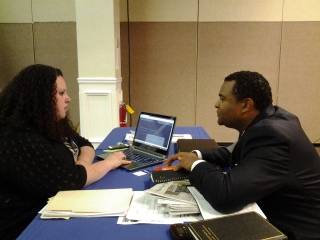Consumers in Georgia and three other states who were helped by navigators for the 2014 insurance exchanges tended to be people of color who were not financially secure, a recently released report says.
Navigators, who are specially trained in the provisions of the Affordable Care Act, provide face-to-face, in-person help for consumers seeking information about health insurance policies in the state exchanges, also called marketplaces.
The report by the University of Georgia also said many consumers helped by Seedco navigators in the four states had limited knowledge about health insurance concepts.
Seedco, a nonprofit group, was the lead organization in Georgia supplying navigators during the last Open Enrollment period for the ACA insurance exchanges. It also provided these counselors in Tennessee, New York and Maryland, and will do so again in the new enrollment period, which starts next month.
A UGA unit was the second Georgia navigator grantee group last year, but it is barred from participating this time by a newly passed state law. Top Georgia officials have been strongly critical of the ACA and have worked to limit official state involvement in its programs.
The UGA report found that among consumers in the four states helped by Seedco navigators, almost two-thirds (64.5%) were people of color. African-Americans were especially prevalent among these Georgia consumers. About 10 percent of consumers preferred to speak a language other than English.
And in a sign that the exchanges tapped a prime target population, 24 percent of people who received Seedco in-person assistance in the four states were between the ages of 18 and 34. That age group was an especially desirable demographic for insurers on the exchange, because young adults’ generally good health was seen as a way to balance the risk from enrollees who were older and had more medical conditions.
Consumers who received in-person assistance generally were not financially secure.
Only about 11 percent said they typically had extra money left at the end of each month for spending or saving. These financial problems (perhaps coupled with lack of insurance) led to unmet medical needs, the report found. More than half of the consumers said they had put off at least one health care visit during the past year because they could not afford it. One-third said they had deferred three or more visits.
Positive response from consumers
Among consumers interviewed for the report, nearly three-quarters expressed enthusiastic satisfaction or used positive language to describe the interaction with navigators.
Several mentioned that they were frustrated that it took them so long to learn that navigators were available to them free of charge. Ben Thomases, Seedco executive vice president, told GHN that many people served by navigators had felt overwhelmed by last year’s enrollment process, which was plagued by online technical problems from the outset. (The glitches were finally corrected, but the process took weeks.)
“They heard about navigators through word of mouth or by referral from an agency,” Thomases said. “People wish they had found out about navigator services earlier.”
On the question of so-called insurance literacy, Thomases said, “many of the consumers have never had insurance, or only had Medicaid.” So terms such as premiums, co-pays, deductibles and provider networks “may be unfamiliar to them,” he said.
With few of these people having discretionary income at the end of the month, Thomases said, “even heavily subsidized premiums can be substantial. People are making painful choices on a monthly basis on what to pay and what not to pay.”
Among consumers whom Seedco Navigators succeeded in enrolling, substantial numbers in New York (70 percent) and Maryland (56 percent) enrolled in Medicaid rather than in private insurance plans. Both states, unlike Georgia and Tennessee, expanded Medicaid eligibility under the ACA.
Still, nearly a quarter of Georgia consumers and more than a third of Tennessee consumers in the Seedco data did qualify for Medicaid.
More than 316,000 people signed up for coverage last year in the Georgia exchange, which was run, as in many states, by the federal government. The enrollments came despite the major technical problems last fall.
Consumers whose exchanges were run by states generally had more success enrolling, noted Cindy Zeldin of the consumer group Georgians for a Healthy Future, which is hiring a navigator to work with Seedco this year.
As the second Open Enrollment period approaches, she said, there is “more need to get the word out about navigators being free and offering unbiased service.”
Those who didn’t sign up previously can enroll for coverage that will starting in 2015, and those who are already covered can renew or change their policies.
Federal officials say that people who are already enrolled will be automatically re-enrolled.
But consumer advocates and policy experts are urging consumers not to put their insurance renewal on autopilot, the New York Times reported. Rather, they advise that when Open Enrollment starts, these people should log on to healthcare.gov to comparison-shop to make sure their current plan is still the best choice.


